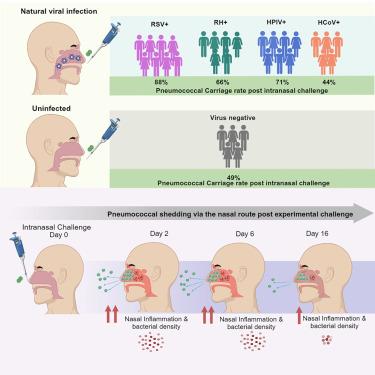Cell Host & Microbe ( IF 20.6 ) Pub Date : 2024-08-23 , DOI: 10.1016/j.chom.2024.07.024 Elena Mitsi 1 , Elissavet Nikolaou 2 , Andre Goncalves 1 , Annie Blizard 3 , Helen Hill 3 , Madlen Farrar 3 , Angela Hyder-Wright 3 , Oluwasefunmi Akeju 4 , Josh Hamilton 3 , Ashleigh Howard 3 , Filora Elterish 4 , Carla Solorzano 1 , Ryan Robinson 3 , Jesus Reiné 1 , Andrea M Collins 3 , Stephen B Gordon 5 , Richard E Moxon 4 , Jeffrey N Weiser 6 , Debby Bogaert 7 , Daniela M Ferreira 1

|
Epidemiological studies report the impact of co-infection with pneumococcus and respiratory viruses upon disease rates and outcomes, but their effect on pneumococcal carriage acquisition and bacterial load is scarcely described. Here, we assess this by combining natural viral infection with controlled human pneumococcal infection in 581 healthy adults screened for upper respiratory tract viral infection before intranasal pneumococcal challenge. Across all adults, respiratory syncytial virus (RSV) and rhinovirus asymptomatic infection confer a substantial increase in secondary infection with pneumococcus. RSV also has a major impact on pneumococcal density up to 9 days post challenge. We also study rates and kinetics of bacterial shedding through the nose and oral route in a subset. High levels of pneumococcal colonization density and nasal inflammation are strongly correlated with increased odds of nasal shedding as opposed to cough shedding. Protection against respiratory viral infections and control of pneumococcal density may contribute to preventing pneumococcal disease and reducing bacterial spread.
中文翻译:

RSV 和鼻病毒会增加肺炎球菌携带量和密度,而鼻腔炎症则与细菌脱落有关
流行病学研究报告了肺炎球菌和呼吸道病毒合并感染对发病率和结果的影响,但它们对肺炎球菌携带获取和细菌载量的影响却很少被描述。在这里,我们通过将自然病毒感染与受控的人类肺炎球菌感染相结合,对 581 名健康成年人进行了评估,在鼻内肺炎球菌攻击前筛查了上呼吸道病毒感染。在所有成年人中,呼吸道合胞病毒(RSV)和鼻病毒无症状感染导致肺炎球菌继发感染大幅增加。 RSV 还对攻击后 9 天的肺炎球菌密度产生重大影响。我们还研究了一部分细菌通过鼻子和口腔途径脱落的速率和动力学。高水平的肺炎球菌定植密度和鼻腔炎症与鼻腔脱落的几率增加密切相关,而不是咳嗽脱落。预防呼吸道病毒感染和控制肺炎球菌密度可能有助于预防肺炎球菌疾病和减少细菌传播。











































 京公网安备 11010802027423号
京公网安备 11010802027423号